Road safety in Canada is changing. More provinces are stepping up with new rules, aiming to protect both drivers and pedestrians. One key move? Speed limiter technology—a smart, effective way to reduce accidents and promote safer highways, especially for commercial fleets.
As fleets across the country prepare for stricter enforcement, many operators are already making the switch. I’ve seen firsthand how much safer roads can become when trucks stay within a safe speed range. That’s why so many fleet managers are now searching for a trusted vehicle speed limiter device Canada to stay compliant and avoid penalties.
Let’s break down why Canada is turning to this technology and what it means for drivers and fleet owners alike.
What is a Speed Limiter and How Does It Work?
A speed limiter is a built-in system that keeps a vehicle from going over a set top speed. It’s like a safety net for the gas pedal. Even if a driver pushes hard, the vehicle won’t go beyond the pre-programmed limit.
These devices work by controlling the engine’s fuel intake or using the vehicle’s electronic control unit (ECU). Many modern limiters are now GPS-enabled, allowing for geo-fenced speed control, which adjusts limits based on location.
Some vehicles come with factory-installed limiters, but in Canada’s trucking sector, many are installed after-market to meet regional laws. It’s not about slowing down your operations—it’s about creating a buffer between speed and danger.
Why Canada is Turning to Speed Limiter Technology
The numbers don’t lie. Speeding is a top cause of traffic fatalities in Canada, especially on highways. With thousands of commercial trucks traveling long distances daily, even one risky maneuver can lead to devastating consequences.
Provinces like Ontario and Quebec have already passed laws requiring speed limiters in commercial vehicles over 11,793 kg. More regions are expected to follow. These changes reflect Canada’s national strategy to reduce greenhouse gas emissions, lower fuel use, and cut down on serious collisions.
Speed limiters aren’t just safety tools—they’re also part of a sustainable transport model. By reducing top speeds, fleets can lower fuel consumption, reduce carbon emissions, and improve operational efficiency.
New Regulations and Compliance Requirements
Canada’s growing push for speed limiters is backed by enforceable rules. In Ontario, for example, trucks must have their limiters set to 105 km/h. Failure to comply can lead to hefty fines, demerit points, and even out-of-service orders.
Upcoming national guidelines from Transport Canada aim to standardize speed limiter requirements across provinces. That means all fleet operators—whether running long-haul freight or local deliveries—need to stay ahead of these regulations.
Inspections are becoming more tech-driven, too. Officials can now check limiter settings via a vehicle’s onboard diagnostics (OBD) port, making it harder to bypass the system.
Benefits of Speed Limiter Technology
There’s a long list of advantages that go beyond just following the law. Here are some top benefits:
- Fewer accidents: Limiting top speed helps reduce the severity of crashes and gives drivers more control.
- Better fuel economy: Studies show trucks with limiters use up to 10% less fuel.
- Lower maintenance costs: Driving at steady speeds reduces wear and tear on tires, brakes, and engines.
- Improved CSA scores: For cross-border operators, using speed limiters can improve compliance with the U.S. FMCSA safety ratings.
- Positive brand image: Companies committed to road safety often gain more trust from clients and the public.
Challenges for Fleet Operators
Of course, not everything is smooth sailing. Speed limiters do come with a few growing pains:
- Installation costs: While prices are dropping, there’s still an upfront investment.
- Driver pushback: Some drivers feel like their control is being taken away. Clear communication and training can help reduce resistance.
- Operational slowdowns: In fast-paced logistics, slowing down by even 5–10 km/h can impact delivery windows. Route optimization and better planning are key.
- Mixed fleets: Managing trucks with and without limiters can complicate scheduling and route assignments.
Still, the long-term benefits almost always outweigh the short-term struggles.
How to Choose the Right Speed Limiter Device
Not all speed limiters are created equal. When picking the right system for your fleet, look for:
- Tamper resistance: A good limiter should lock out unauthorized changes.
- Compatibility: Make sure it works with your vehicle’s ECU and telematics system.
- Adjustable settings: Some routes may require different speed limits—flexibility helps.
- Real-time monitoring: Some advanced systems let you track speed compliance remotely.
- Vendor support: A responsive provider can make installation, updates, and maintenance a lot easier.
Choosing a certified, Canadian-compliant product is essential for passing inspections and avoiding penalties.
Future Outlook: Smart Speed Limiters and Connected Fleets
Looking ahead, the industry is heading toward intelligent speed assistance (ISA). These are advanced systems that use real-time data to adjust vehicle speed automatically based on the posted limit.
Imagine your truck slowing down as it enters a school zone—without driver input. This is where things are going, especially with connected vehicle tech and autonomous systems on the rise.
Canada’s Vision Zero initiatives are also expected to push for mandatory smart speed limiters across commercial fleets in the next few years. Getting ahead of the curve now gives fleet operators a major advantage.
Conclusion
Speed limiter technology is more than a safety feature it’s a shift in how we think about responsible driving in Canada. It protects lives, reduces fuel use, and helps fleets stay on the right side of the law.
The transition might feel like a big step, but with the right tools and mindset, it’s a step in the right direction. For fleet owners, now is the time to prepare because the road ahead is changing.
